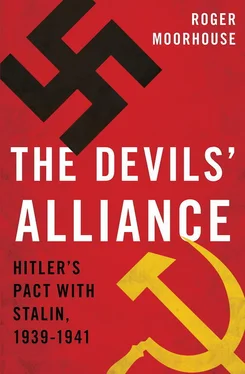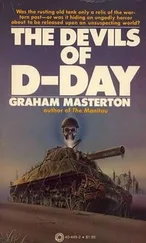Roger Moorhouse - The Devils' Alliance - Hitler's Pact with Stalin, 1939-1941
Здесь есть возможность читать онлайн «Roger Moorhouse - The Devils' Alliance - Hitler's Pact with Stalin, 1939-1941» весь текст электронной книги совершенно бесплатно (целиком полную версию без сокращений). В некоторых случаях можно слушать аудио, скачать через торрент в формате fb2 и присутствует краткое содержание. Город: New York, Год выпуска: 2014, ISBN: 2014, Издательство: Basic Books, Жанр: История, Публицистика, dissident, на английском языке. Описание произведения, (предисловие) а так же отзывы посетителей доступны на портале библиотеки ЛибКат.
- Название:The Devils' Alliance: Hitler's Pact with Stalin, 1939-1941
- Автор:
- Издательство:Basic Books
- Жанр:
- Год:2014
- Город:New York
- ISBN:978-0-465-05492-3
- Рейтинг книги:5 / 5. Голосов: 1
-
Избранное:Добавить в избранное
- Отзывы:
-
Ваша оценка:
The Devils' Alliance: Hitler's Pact with Stalin, 1939-1941: краткое содержание, описание и аннотация
Предлагаем к чтению аннотацию, описание, краткое содержание или предисловие (зависит от того, что написал сам автор книги «The Devils' Alliance: Hitler's Pact with Stalin, 1939-1941»). Если вы не нашли необходимую информацию о книге — напишите в комментариях, мы постараемся отыскать её.
, acclaimed historian Roger Moorhouse explores the causes and implications of the tenuous Nazi-Soviet pact, an unholy covenant whose creation and dissolution were crucial turning points in World War II. Indeed, this riveting chapter of World War II is the key to understanding why the conflict evolved—and ended—the way it did.
Nazism and Bolshevism made unlikely bedfellows, but the brutally efficient joint Nazi-Soviet invasion of Poland in 1939 illustrated the powerful incentives that existed for both sides to set aside their differences. Forged by vain and pompous German foreign minister Joachim von Ribbentrop and his Russian counterpart, the inscrutable and stubborn Vyacheslav Molotov, the Nazi-Soviet pact in August of 1939 briefly unified the two powers. Together, the Germans and Soviets quickly conquered and divvied up central and eastern Europe—Poland, the Baltic States, Finland, and Bessarabia—aiding one another through exchanges of information, blueprints, and prisoners. The human cost was staggering: in Poland alone, the Soviets deported 1.5 million people in 1940, 400,000 of whom would never return. Tens of thousands were also deported from the Baltic States, including almost all of the members of the Estonian parliament. Of the 100,000 civilians deported to Siberia from Bessarabia, barely a third survived.
Nazi and Soviet leaders hoped that a similar quid-pro-quo agreement would also characterize their economic relationship. The Soviet Union would export much-needed raw materials to Germany, while the Germans would provide weapons and technological innovations to their communist counterparts. In reality, however, economic negotiations were fraught from the start, not least because the Soviets, mindful that the Germans were in dire need of raw materials to offset a British blockade, made impossible demands of their ally. Although German-Soviet trade still grew impressively through 1940, it was not enough to convince Hitler that he could rely on the partnership with Moscow, which on the whole was increasingly turbulent and unpredictable.
Fortunately for the Allies, the pact—which seemed to negate any chances of an Allied victory in Europe—was short-lived. Delving into the motivations and forces at work, Moorhouse explores how the partnership soured, ultimately resulting in the surprise June 1941 German invasion of the Soviet Union. With the final dissolution of the pact, the Soviets sided with the Western democracies, a development that changed the course of the war—and which, upon Germany’s defeat, allowed the Soviets to solidify the inroads they had made into Eastern Europe during their ill-starred alliance. Reviled by contemporaries, the Nazi-Soviet Pact would have a similarly baleful afterlife. Though it was torn up by the Nazis and denied or excused as a strategic necessity by the Soviets, its effects and political ramifications proved remarkably persistent. The boundaries of modern eastern and central Europe adhere closely to the hasty divisions made by Ribbentrop and Molotov. Even more importantly, the pact laid the groundwork for Soviet control of Eastern Europe, a power grab that would define the post-war order.
Drawing on memoirs, diaries, and official records from newly opened Soviet archives,
is the authoritative work on one of the seminal episodes of World War II. In his characteristically rich and detailed prose, Moorhouse paints a vivid picture of the pact’s origins and its enduring influence as a crucial turning point, in both the war and in modern history.












